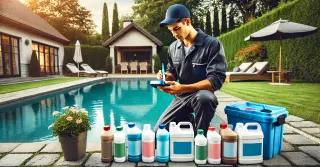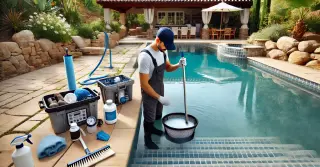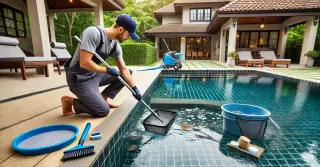Pool Chemical Balance Rochelle Park NJ

Keeping your pool's chemical balance in check is crucial for a safe and healthy swimming environment. Balanced chemicals inhibit algae and bacteria, maintain clear, clean water, and protect the pool's surface and equipment.
- Optimal pH Balance: The pH balance in your pool reflects its acidity or alkalinity. A balanced pH level should be between 7.2 and 7.6. If the pH is too low, the water becomes acidic, which can cause skin irritation and corrosion of pool equipment. If the pH is too high, the water becomes alkaline, leading to cloudy water and scaling on the pool surfaces. Frequent pH testing and adjustments is vital for swimmer comfort and safety.
- Managing Chlorine Concentration: Chlorine plays a crucial role in pool sanitation, killing bacteria, algae, and other harmful microorganisms. The proper chlorine level is between 1-3 ppm. Too little chlorine can lead to unsanitary conditions, allowing bacteria and algae to thrive. High chlorine levels result in skin and eye irritation and produce a strong chlorine odor. Frequently checking and balancing chlorine levels ensures effective sanitation and swimmer comfort.
Optimal Alkalinity LevelsTotal alkalinity is another critical aspect of pool water chemistry. Alkalinity acts as a buffer for pH levels, avoiding sudden pH changes. The ideal range for total alkalinity is between 80-120 ppm.
- Avoiding pH Fluctuations: Proper alkalinity levels help stabilize pH levels, preventing rapid pH changes that irritate skin and damage surfaces. Low alkalinity causes pH levels to fluctuate, making consistent balance difficult. If alkalinity is too high, it can make the water cloudy and lead to scaling. Consistently monitoring and adjusting alkalinity levels is crucial for stable and balanced water.
- Managing Calcium Hardness: Calcium hardness refers to the amount of dissolved calcium in the pool water. The ideal range for calcium hardness is between 200-400 ppm. Low calcium levels result in corrosive water, harming surfaces and equipment. Excessive calcium causes scaling and water cloudiness. Consistently monitoring and adjusting calcium hardness is important for protecting your pool and ensuring clear water.
Using Pool Chemicals SafelyUsing and storing pool chemicals safely is crucial for safety and efficiency. Store chemicals in a cool, dry place, away from direct sunlight and out of reach of children and pets. Always follow the manufacturer's instructions for proper dosing and application.
- Measuring and Mixing Chemicals: Measuring pool chemicals accurately is vital for correct balance. Using too much or too little can disrupt the chemical balance and affect water quality. Always use a clean, dry measuring cup or scoop and never combine chemicals directly. Mix in water as needed, following guidelines carefully.
- Awareness of Chemical Reactions: Certain chemicals can react dangerously if mixed. Never mix chlorine with acid, for example. Being aware of these interactions helps prevent accidents and ensures safe handling. Keep chemicals separate and handle with caution to prevent harmful reactions.
Maintaining the proper chemical balance in your pool is essential for a safe, clean, and enjoyable swimming environment. By consistently testing and adjusting pH, chlorine, alkalinity, and calcium, you ensure optimal water quality.
Safe use and storage of pool chemicals enhance the health and safety of your pool.




